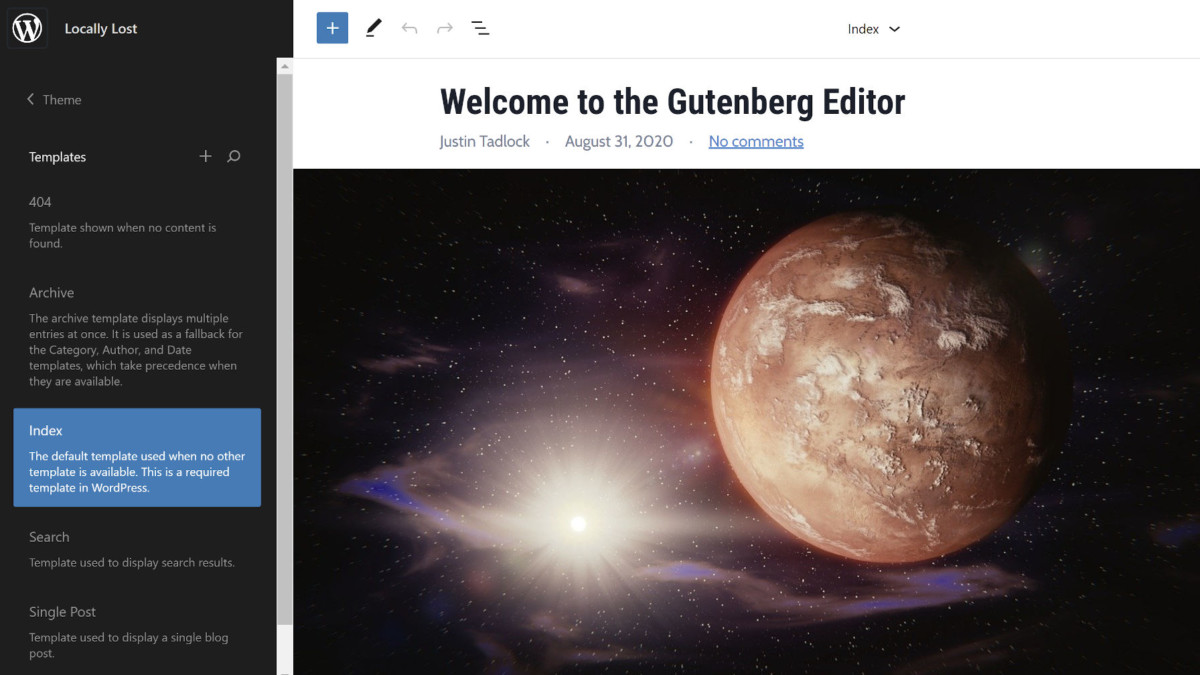Earlier today, the WPMarmite team released a massive study of 127 WordPress theme shops. It primarily focused on integration with the block editor. The team also surveyed 22 of the shops directly to dive deeper into what the future might look like when the Full Site Editing (FSE) project is entirely bundled into the core platform, which could be around the WordPress 5.9 release in late 2021.
FSE is not a single thing that WordPress will drop on users all at once. It is an ongoing project with several independent but related components that will ship based on their readiness. The goal is to move the block system beyond just content, bringing blocks into all facets of a site’s front end.
Single post/page template editing and block-based widgets are expected to arrive with WordPress 5.8 in July. These are two user-facing components that serve as stepping stones toward a complete FSE experience.
Putting study into context, FSE-related discussion for theme authors is mainly about block templates and global styles. These components will create a drastic change to theme development where templates are made up of blocks themselves and styles are configured via a JSON file. For the first time in WordPress’s history, users will be able to directly edit both from an interface in their site admin without knowing any code.
 Upcoming site editor with templates (left panel) and global styles (right panel).
Upcoming site editor with templates (left panel) and global styles (right panel).
WordPress 5.0, the first version to include blocks, launched two and a half years ago. Theme authors have had time to catch up, migrate old projects, and create new ones. WPMarmite’s study gives a solid, at-a-glance view of how shops are fairing now that the shockwave of the block system’s introduction has long settled.
The Study: Block Editor Support
The primary takeaway from the 127-shop study was that 57% of them featured their compatibility with the block editor in some way. Short of testing themes from each site individually or directly asking them all, there is no other way to know how many actually offer support. My guess is the number is not much higher.
Technically, all themes “work” with the WordPress editor. However, not all are designed from the ground up to offer an ideal experience with it. As a commercial theme shop, you would want to mention this support somewhere in your marketing.
Even if that 57% is dead-on, a shop featuring block support does not always mean solid support. In my experience of viewing themes and their demos almost daily, “support” often means minimal adjustments to make sure the basics do not break the site. That number is far lower if you are counting themes that offer an immersive block-editor experience.
The number that was surprising but not surprising was the percentage of shops currently providing block patterns. Only 3% (4 in total) bundle custom patterns.
 Inserting a block pattern into the WordPress editor.
Inserting a block pattern into the WordPress editor.
While the patterns API has only been around since WordPress 5.5, released less than a year ago, it is one of those crucial tools for the future of theme development. I thought the number was low. I just did not know it was 3% low.
If 57% of shops offer some level of block editor support, why are they stopping short of complete integration and not using the most powerful features at their disposal?
Patterns are part of that immersive experience I mentioned. If a shop does not have any, I would question how much it actually supports the block system.
In the WordPress.org free theme directory, that percentage is much higher. Currently, 514 themes add block editor styles, and 120 bundle at least one pattern.
Note: if you combine those two filters, the directory lists 107 themes. Some could be missing a tag.
One data point the team missed was how many of these theme shops integrated with third-party page builders. I would wager that most of the ThemeForest authors support at least one additional builder, maybe two. It is almost a sure-fire bet that Elementor and Beaver Builder top that list. While the study was on the core block system, this would have given us a more accurate look at the current theme market.
The Survey: FSE and the Future
Of the 127 shops, WPMarmite surveyed 22 of them with questions around FSE. The most telling statistic is that 82% of shops follow FSE-related news, citing WP Tavern as one of their sources. Thank you, dear readers.
On a more serious note, 86% of those surveyed believe that FSE will be a breakthrough for users. I am not surprised at this. Many features that theme authors have attempted to accomplish over the last decade are being rolled into the Gutenberg plugin. It is a slow process, but having the pieces built into WordPress provides standard APIs that will make themers’ jobs easier. In turn, this will allow them to launch features that users ask for with less code and a faster turnaround.
The number I want to see higher is those actively preparing for block templates and global styles. According to the survey, only 22% are doing so.
These components are continually in flux. However, the foundational elements are far more stable than they were just a few months ago. This makes it a good moment for others to start diving in — there is less chance of breaking changes with the system. I expect the percentage of commercial theme shops working with FSE to jump throughout the year. However, it could be a slow process getting to the point where such themes are commonplace. We may need to see a breakout block theme that quickly rises in popularity first. Everyone else will fall in line.
In the meantime, if anyone wants to experiment with FSE, there are six themes listed in the directory.
Like this:
Like Loading…





